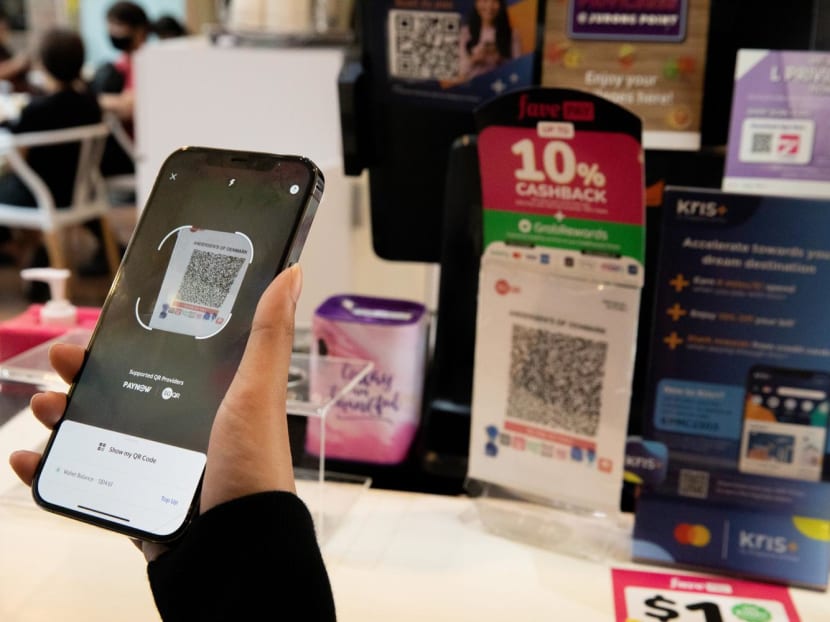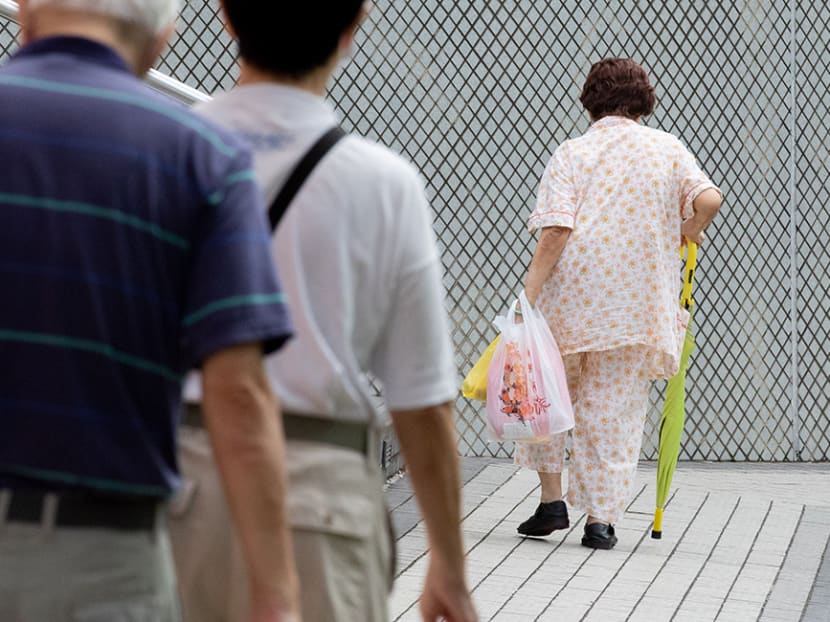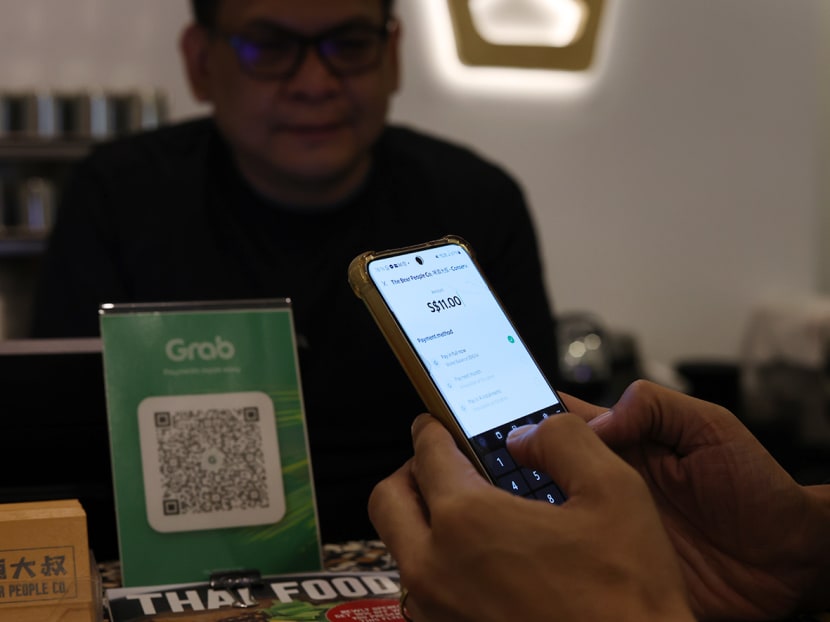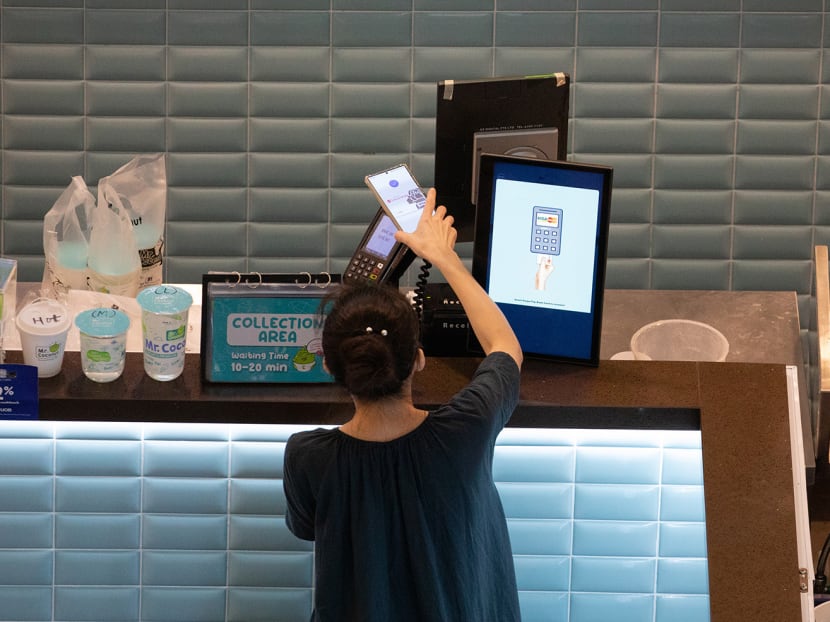The Big Read: Can S’pore find the right balance as e-payments become the norm?
SINGAPORE — On most days, Ms Pang Shi Jia leaves her home with only her phone and card holder, which contains two bank cards.

With e-payments taking off here in recent years — amid the Covid-19 pandemic and an ongoing national drive for a less-cash society – a growing majority of consumers are opting to pay for goods and services using their cards or phones.
- The Covid-19 pandemic has accelerated the adoption of electronic payments, with many users choosing not to carry cash around
- Singapore’s adoption rate of cashless payments is now the highest in Southeast Asia
- However, seniors are less inclined to adopt cashless payments while recent service disruptions and rise of scams have also raised concerns among younger users
- To enhance the resilience of e-payment systems, experts suggest having multiple payment options available and educating consumers about e-payment technologies
- Offline e-payments are also a potential solution, though the technology is still underdeveloped and has its own downsides
SINGAPORE — On most days, Ms Pang Shi Jia leaves her home with only her phone and card holder, which contains two bank cards.
“I don’t even remember when was the last time I withdrew cash to spend,” said the 26-year-old public servant.
With most places she frequents accepting contactless payments, Ms Pang does not see the need to carry any notes or coins at all.
Ms Renny Tan, 23, also pays for her food and other purchases through cashless means, preferring to use her smartwatch, which contains her credit card details, most of the time.
“I think it’s very convenient because you just tap (the watch on the payment terminal) and go. I don’t like having to take out my wallet, pull out my cash and count, the process is so long,” said the interior designer.
For others, paying electronically also makes it easier to track their expenses.
“Since there is a digital record of all my transactions, it makes it very convenient to note down my spending habits,” said 26-year-old April Liew, who works in the advertising industry.
With e-payments taking off here in recent years — amid the Covid-19 pandemic and an ongoing national drive for a less-cash society — these users are part of a growing majority who opt for using their cards or phones to pay for goods and services.
Many users also use cashless platforms to transfer money to other individuals, such as friends or family members.
Singapore’s adoption rate of cashless payments is the highest in Southeast Asia at 97 per cent, based on payment methods at Singapore retail points-of-sale in 2022, according to a 2023 survey published by German statistics company Statista.
Cashless payment types consist of credit and debit cards, as well as electronic wallets, such as Apple Pay and Samsung Pay, which allow users to store their credit card details.
They also include smartphone payment applications such as DBS PayLah! and GrabPay, which enable users to top up and store money in their “virtual wallet” on the app.
Another commonly used e-payment service is PayNow, which was launched in 2017.
PayNow is a funds transfer service that allows customers of 10 banks and four non-bank financial institutions to send and receive Singapore dollar funds from one bank or e-wallet to another in Singapore instantly.
They are able to do so with their mobile number, Singapore NRIC or virtual payment address.
This service is available for customers of banks such as DBS/POSB and OCBC, as well as non-bank institutions such as GrabPay and Singtel Dash.
For certain banks such as United Overseas Bank (UOB) and OCBC, users can also withdraw their money from the automated teller machines (ATMs) with their mobile phones, eliminating the need to carry a bank card around.
OCBC customers are able to use the Pay Anyone app to scan a quick response (QR) code generated by the ATM in order to withdraw cash.
Digital wallets are expected to overtake credit cards as the most popular online payment method in Singapore by 2026, according to a 2023 Global Payments report by financial technology company FIS.
This rise in cashless payment was accelerated by the Covid-19 pandemic, which saw people avoiding the use of cash to minimise contact.
As of 2022, more than 210,000 merchants operating across various service industries, including retail stores in shopping malls and food stalls at hawker centres, offer SGQR as a means of payment acceptance, said Monetary Authority of Singapore (MAS) chairman Tharman Shanmugaratnam in Parliament last year.
This accounts for over 90 per cent of merchants in Singapore, he added.
The SGQR, which was launched in September 2018, combines multiple payment schemes into a single label.
In response to TODAY’s queries, DBS said that its digital wallet application DBS PayLah! records more than 25 million logins per month.
There was also a 24 per cent year-on-year growth in PayLah! transactions in 2022, and a 69 per cent year-on-year growth in 2021, according to the bank’s annual reports.
Usage of PayNow, including payments to merchants and businesses, reached S$46 billion in 2021, said Mr Tharman in Parliament last year.
He added that nearly 5.5 million bank accounts are registered with PayNow, with 3 million linked to mobile phone numbers and another two million linked to NRIC numbers.
SENIORS FIND IT HARD TO EMBRACE E-PAYMENTS
However, not everyone is enamoured with the “simplicity” of cashless payments.
Seniors in particular prefer handling cash as electronic means are too complicated for them, with the rise of scams further impeding their adoption among this group.
Retiree Peggy Wang told TODAY that she still pays with cash despite her children’s repeated attempts at teaching her how to make mobile payments.
“There are too many buttons (in the application) that it gives me a headache,” said the 65-year-old in Mandarin.
“I’m also scared that I will key in the wrong amount and have all my hard-earned money disappear,” she added.
Agreeing, 72-year-old Huang Ying Hua said that she is afraid of getting scammed.
“There are so many scammers nowadays, they might ask me for some details and I might unknowingly transfer money to them because it’s so easy,” said the retiree, who used to work as a hawker.

During the DBS service disruption earlier this month, which happened just two months after another one lasting almost a whole day, Ms Tan had to borrow cash from her colleagues to pay for lunch as she had none in her wallet.
“I was panicking because I was wondering if the whole bank was getting hacked or something.” she said.
The DBS service disruptions are not the only such cases here so far.
On June 9, 2022, OCBC bank customers were unable to access the bank's online payment services, in a disruption that lasted slightly over two hours.
Similarly, UOB customers were unable to log in to the mobile bank application or make transactions for several hours on Feb 4, 2022.
ENHANCING RESILIENCE OF E-PAYMENTS
Against the backdrop of such disruptions in services, business and technology experts told TODAY that having multiple payment options available is one way to ensure the resilience of the e-payment landscape here, a paradigm shift from just a few years ago.
In 2017, analysts had suggested that banks and other industry players come together to unify the fragmented landscape.
Analysts who spoke to TODAY then said that the fragmented ecosystem with a multitude of payment options was inconveniencing customers as they had to carry various cards.
Businesses also had to bear the cost of installing multiple readers.
However, with the recent service disruptions and rise of scams, some experts now see the benefits of multiplicity.
Associate Professor Liang Zhen Kai from the School of Computing at the National University of Singapore (NUS) said that he has two bank accounts — one of which he tops up regularly with a smaller amount for spending.
The other is a bank account that he uses only to save money.
Dr Douglas Streeter Rolph, a senior lecturer of finance at the Singapore University of Technology and Design, added that having multiple options would also allow for financial inclusion.
For instance, a store that accepts only Apple Pay may exclude those who could not afford an Apple smartphone.
“I think it’s important to build systems that allow for people of all levels of income to access that financial system,” he said.

This would include educating the public more on financial literacy and helping them understand e-payment technologies.
This could help users be more tech-savvy and alert to potential scams.
For instance, she has observed that seniors tend to receive "rules" on how to avoid scams.
These include not revealing their passwords to others or not downloading QR codes.
"So when they go to a restaurant and the menu is on a QR code, the rule of not downloading anything with a QR code does not work," she said.
"So it gets really complex very quickly. My point is to expand our education to the logic of security mechanisms," she said.
Introducing “friction” into the system to ensure there are safeguards such as cooldown periods and lower payment thresholds would also help prevent overspending or scams, she said.
On the technical aspect, Mr Paul Ng, a financial services lead for Southeast Asia at professional services firm Accenture, said that banks should leverage emerging technologies such as cloud, digital currency, biometric authentication and artificial intelligence.
This would help them create modern, compliant and secure payment infrastructure, said Mr Ng.
E-WALLETS SANS INTERNET CONNECTION
With the internet being the basic block of all cashless systems, what about mobile e-wallets that could allow users to make payments without the internet?
China’s WeChat conducted a trial in 2019 which allowed users to make offline payments on board flights, allowing passengers to pay for items like food and drinks on the plane.
The bill will be stored on the application until the flight lands.
The trial with Spring Airlines during flights between Chengdu and Shanghai lasted for four days and the company said then that it plans to expand the new payment service to more flights, though there have been no announcements about it yet.
This is similar to how credit cards work on flights, with credit card transactions being processed when the aircraft lands.
Currently, smartphone payment applications such as DBS PayLah! and GrabPay require an internet connection to make a payment.
When asked why there does not seem to be more offline payment applications in the market, Ms Lim pointed out that it is currently being explored, but to a limited degree.
This is because offline payments could fundamentally undermine the benefits of real-time payments, which is to clear and settle financial transactions within seconds at any time.

For offline payments, as the transaction would only be settled later when there is internet access, this would re-introduce the risk of buying and collecting a product without verification of one’s credit worthiness.
“This would be tantamount to writing a bad cheque that would bounce,” she said.
A payment provider would need to support or account for that level of risk, said Ms Lim.
However, Assoc Prof Liang said that such offline wallets could possibly use Near Field Communication (NFC) technology to transfer funds from one smartphone to another by tapping them together, so users can still have their payments recorded in real time.
NFC is a technology that allows devices like phones and smartwatches to transmit data wirelessly over short distances using radio waves.
It is used for e-wallets such as Apple Pay as well as credit cards, allowing users to tap their phone or card onto the payment terminal to pay.
The payment terminal is connected to the internet or a phone line which will then send a signal to the bank to carry out the transaction.
If the terminal is connected to a phone line, an internet connection is not required to carry out the payment.
Although offline wallets could bring benefits such as facilitating payments in the event of an internet outage, Assoc Prof Liang does not foresee them entering the market anytime soon as the technology is still underdeveloped.
GETTING SENIORS ONBOARD
To encourage more seniors to adopt digital payments, Mr Ng of Accenture urged banks to connect more “authentically and emotionally” with the communities they serve.
A 2023 Global Banking Consumer Study by Accenture found that more than 69 per cent of Singapore respondents turned to banks’ branches to solve specific and complicated problems.
“Increasing the availability and accessibility to banking personnel could help in educating the elderly in e-payments and aid in overall higher adoption rates,” he said.
In many countries, seniors are still averse to adopting e-payment methods, preferring the traditional paper money.
However, several countries such as Sweden and China — where e-payment adoption rates are extremely high — seem to be ahead of the curve in getting reluctant seniors to go cashless.
According to Sweden’s central bank Riksbank, the proportion of Swedes using cash fell from 39 to 9 per cent from 2010 to 2020.
Mr Nima, a Swede who moved to Singapore five years ago and is working in the financial technology industry, noted that Swedes in general, including the seniors, are more open to adopting new technology.
“The Swedes are okay with taking risks — they jump onto new technologies and new opportunities, seeing the upside instead of the risks,” said the 41-year-old, who declined to give his full name.
He added that the country had also started pushing for cashless payments early, such as prohibiting stores from implementing a surcharge for credit card payments.
E-payment adoption is also high in China, with many shops and even taxi drivers refusing to accept cash.
This is in part due to the widely adopted WeChat, an application which functions as both a messaging and payment application.
“They have piggy-backed on this already very popular application that everyone in China has so it makes the learning curve less steep (for seniors),” said Assoc Prof Liang of NUS.
Owned by Tencent, the payment service was launched in 2013 — just two years after the application was launched.
However, Assoc Prof Liang said that he does not think Singapore should have a single application like WeChat, as this would result in a single point of failure, where just one flaw can cause the whole system to stop operating.
Professor Lawrence Loh, director of the centre for governance and sustainability at NUS Business School, added that vendors in China were offered numerous incentives to adopt WeChat and Alibaba-owned Alipay.
This resulted in many stores adopting both payment systems and even rejecting cash, leaving people, including seniors, with little choice but to learn how to pay with their phones.
He suggested having more incentives to get seniors here onboard, such as discounts, free gifts or lucky draws for those who adopt cashless payments.
“I think the elderly can definitely adapt with some patience and some learning,” he said.

For instance, Prof Loh said that he has observed many seniors being able to use the Singapore Pools mobile application, a smartphone app that allows people to access online betting services.
“Suddenly the old people are so good at using the application to check the lottery and that’s because there is a need and incentive for them to learn,” he said with a chuckle.
SHOULD SINGAPORE GO CASHLESS?
Despite the ubiquity of e-payments here, then-MAS board member Ong Ye Kung had told Parliament in 2021 that Singapore does not aim to be a cashless society.
"We are promoting e-payments because it is efficient, convenient and green. But we are not aiming to be a cashless society. Cash will continue to be a familiar and convenient way to transact," Mr Ong, who is currently the Health Minister, had said.
Experts agreed that Singapore should not go fully cashless as cash still plays an important role here, especially among the elderly.
It also serves as a “fallback” when e-payment systems are down.
Ms Lim of Access Partnership said that one of the biggest risks in becoming a cashless society would be to “place our trust in a system with a single point of failure”.
If there were an electricity or internet outage for instance, people would not be able to carry out payments.
“To be a truly resilient country, there should be alternatives available to us — slower and perhaps more cumbersome, but we have to build these redundancies if we are to build a resilient financial ecosystem,” she said.
Ms Lim added that removing cash completely would run the risk of accidental policy exclusion, leaving out some vulnerable groups such as seniors, those with dementia or people with reduced level of memory and faculties.
Memory loss is also a concern for social worker Joseph Lim.
Mr Lim told TODAY that he uses cash 95 per cent of the time as he believes e-payment is not the “most stable way” of making payments since systems could break down anytime.
“And I’m already 61, so for older folks, there is that fear of forgetting — like what is my password or pin number?” he said.

THE BEST BALANCE
Most users TODAY spoke to were content with just carrying their phones and wallets, despite the recent banking service disruptions, though they did hope to see several improvements in the e-payment space.
Ms Tan, the interior designer, said that she hopes interfaces of payment applications could be simplified further.
“Sometimes the steps to do payments in the apps are too troublesome,” she said.
For Ms Liew, she hopes to see more vendors adopt cashless payments, so that it would be more convenient for users.
But as Singapore continues its push for e-payments, experts told TODAY that having multiple payment options while still keeping some cold cash on hand in the event of a service disruption is the best balance for now.
Referring to the need for options, alternatives, and resilience, Ms Lim said: “We can aim for a cashless society, but let’s not miss the forest for the trees.”
Agreeing, Dr Rolph said: “Carry a little extra cash or make sure that you have some friends who do.”
CORRECTION: An earlier version of this article stated that DBS bank and OCBC bank users can withdraw their money from automated teller machines with their mobile phones. This is inaccurate. It should be United Overseas Bank and OCBC bank users. We are sorry for the error.











